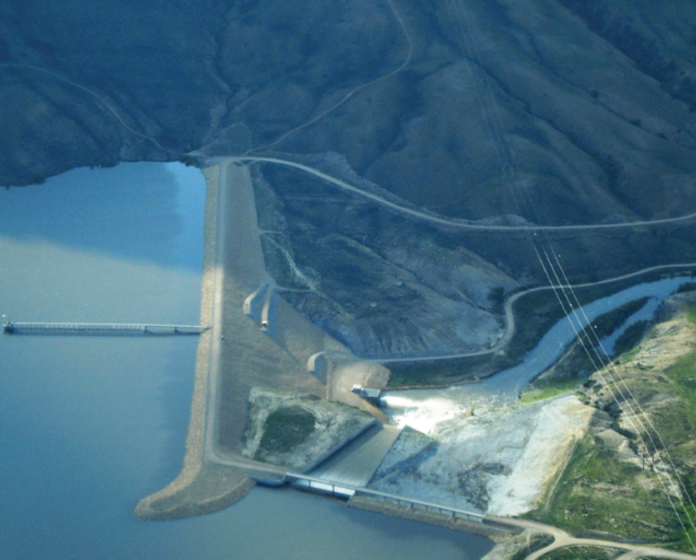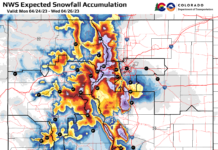by Marissa Lorenz
The safety of the Ritschard Dam at Wolford Mountain Reservoir was a topic of discussion at both the weekly Kremmling Town Council meeting and the quarterly meeting of the Colorado River Water Conservation District (CRWCD)
on Wednesday, January 20.
A summary of a recently completed comprehensive dam safety evaluation report was presented at both meetings by Hunter Causey, Senior Engineer at the CRWCD.
The results of this most recent assessment, conducted by a panel of experts, found “a much higher risk of dam failure than reported previously,” stated Causey. Specifically, he reported the currently assessed risk of dam failure “in any given year” to be 1 in 10,000, compared to an annual risk factor of 1 in 1 billion that came out of the previous safety evaluation, completed in 2016.
Causey was quick to point out to the CRWCD Board that the most recent numbers are equivalent to the risk factors of dams constructed prior to modern safety measures, that “there is a poor level of confidence in that assessment,” and that the greatest risk was for damage states to occur at the transition points between the main valley of the dam and the adjacent abutments.
Causey described “damage states” as “events that don’t result in dam failure, don’t pose a risk to the public, don’t mean flooding of downstream communities or anything extreme like that. But it’s a scenario that still has adverse impacts.”
He offered the example of staff “identifying a problem at the dam related to settlement that necessitated storage restrictions or remediations. We’re not talking about a public health/safety risk. We are talking about impacting the ability to release water downstream and fulfill the purpose of the reservoir. The risk of those events is found to be extremely high.”
Causey admitted that it is “hard to reconcile that discrepancy” of a risk factor that is now considered to possibly be 100,000 times more than previously estimated. But he indicated that the report offered possible explanations as well.
The first is the increased risk of cracking at the transition points, as the main valley of the dam deforms at a faster rate than the abutments. The second is a lesser level of confidence in the filtering ability of a sand filter, designed as a modern safety precaution that should capture eroded particles from the dam’s clay core, preventing them from continuing to travel downstream.
But the engineer noted that the report also included recommended actions, recommendations that
do not include any call to rebuild or even complete any major construction in the near future.
The report recommended three primary responses: conduct filter testing to determine if the sand filter is catching eroded particles
as intended, increase monitoring, and increased instrumentation.
Causey indicated that the River District had already begun acting on the recommendations, sending samples from the sand filter to a lab in Denver; planning a comprehensive survey program that would permit a closer look at the dam, using such tools as LIDAR and satellite data collection; and looking at instrumentation needs.
Additional precautions will include implementing a voluntary reduced operating pool, which will keep the reservoir fill level at 10 feet below the spillway in an effort to prevent water from spilling in 2021; refining the dam’s emergency preparedness. further coordinating with emergency management at the town and county, and increasing stockpiled materials at the dam site.
Causey assured that staff did not expect the reduced water levels to significantly diminish recreational opportunities at the reservoir in the coming summer season, though levels could drop to a much lower level later in the year as water reserves may be called upon in what has so far been a very low-precipitation year.
Causey concluded both presentations by emphasizing that Colorado River District’s “highest priority is public health and safety, with water storage and finances being a second priority.”
There has been vacillating concern over the integrity of the dam structure for at least the last decade. The Ritschard Dam is an earthen dam with an impervious clay core, measuring 1,735 feet across and 140 feet at its greatest height. It was completed in 1996 and holds back 66,000 acre-feet of water when at capacity. It releases into Muddy Creek, six miles north of Kremmling.
Earthen dams are expected to shift due to settling, and all have some water seepage, which is diverted at Wolford by an internal drainage system. But engineers felt that the dam was settling more than anticipated as early as 2008. They sought the opinion of an expert panel in 2011, which determined no risk to the dam structure.
In early 2015, the CRWCD was warned by a staff engineer that the movement of the Ritschard dam was “the most important issue” then facing the River District. It was reported at that time that, given a dam failure, up to 600,000 cubic feet per second would travel downstream toward Kremmling, with a “massive surge” of water reaching Glenwood Springs around 18 hours later.
A risk analysis workshop in 2016 then concluded that the dam was safe and needed no immediate action and, following several years of voluntarily reduced water levels, determined that the precaution
was no longer necessary.
However, a Denver Water employee issued a memo following that conclusion, reading, “While the probability of a dam failure appears low, dam failure is not the only potential adverse impact of concern to Denver Water. The probability of cracking in the core of the dam, which could reduce storage capacity, has a much greater range of uncertainty.”
For questions or comments on the most recent comprehensive risk assessment, conclusions, and mitigating actions, contact Audrey Turner, Colorado River District Chief of Operations at aturner@crwcd. org or 970.945.8522 ext. 1228.








